James Van Allen
James Alfred Van Allen (September 7, 1914 – August 9, 2006) was an American space scientist at the University of Iowa. He was instrumental in establishing the field of magnetospheric research in space.
James Van Allen | |
|---|---|
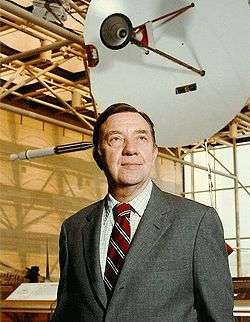 James Van Allen in 1977 | |
| Born | James Alfred Van Allen September 7, 1914 |
| Died | August 9, 2006 (aged 91) |
| Nationality | American |
| Alma mater | Iowa Wesleyan College (B.S.) (1935) University of Iowa (M.S.) (1936) University of Iowa (Ph.D) (1939) |
| Known for | Van Allen radiation belts Magnetospheric physics[1] |
| Awards | Time magazine Man of the Year (1960) Elliott Cresson Medal (1961) William Bowie Medal (1977) National Medal of Science (1987) Crafoord Prize (1989) Vannevar Bush Award (1991) |
| Scientific career | |
| Fields | Astrophysics |
| Institutions | University of Iowa |
| Doctoral advisor | Alexander Ellett https://academictree.org/physics/tree.php?pid=31481 |
| Notable students | Nicholas M. Smith |
| Influenced | James Hansen |
The Van Allen radiation belts were named for him, following his discovery using Geiger–Müller tube instruments on the 1958 satellites (Explorer 1, Explorer 3, and Pioneer 3)[2][3][4] during the International Geophysical Year. Van Allen led the scientific community in putting scientific research instruments on space satellites.
Early years and education
Van Allen was born on 7 September 1914 on a small farm near Mount Pleasant, Iowa, the second of four sons of Alfred Morris and Alma Olney Van Allen, a woman of Dutch ancestry (van Allen being Dutch for "from Allen/Aalden"[5]). He grew up in the small town of Mount Pleasant, 45 miles south of Iowa City. As a child, he was fascinated by mechanical and electrical devices and was an avid reader of Popular Mechanics and Popular Science magazines. He once horrified his mother by constructing a Tesla coil that produced foot-long sparks and caused his hair to stand on end.[6] Van Allen credits C. A. Cottrell, a science instructor in his high school, with stimulating his initial interest in science. He developed parallel interests in wood and metal crafts and did well in other subjects, becoming valedictorian of his Mount Pleasant High School class upon his graduation in June 1931. His valedictorian address was: Pax Romana, Pax Americana.
With a strong interest in things nautical (which he retained throughout his life), he took the entrance examinations for entry into the U.S. Naval Academy while in high school. With outstanding grades, and with the backing of his local Congressman, William F. Kopp, he applied for admission. All went well initially, but when he appeared for his physical examination, he was rejected for three reasons: his flat feet, somewhat deficient eyesight, and inability to swim. Hence, he pursued a different path.
Following high school, Van Allen went to Iowa Wesleyan College in Mount Pleasant. There, during the summer of 1932, after completing his freshman year, Van Allen was introduced to geophysics research under the tutelage of physics professor Thomas C. Poulter. Van Allen had great admiration for this early mentor. He stated in one of his autobiographical sketches, "Poulter, [was] one of the most inspiring and creative experimentalists that I have ever known before or since that time...." Poulter employed him as a summer assistant, "at 35 cents an hour, payable occasionally."[7] Van Allen majored in physics and graduated summa cum laude with his 37 classmates in June 1935.
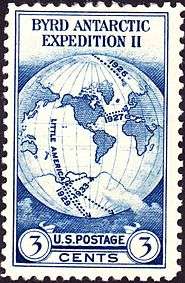
Poulter had been chosen by Admiral Richard E. Byrd as his chief scientist for the 1933–1935 Second Byrd Antarctic Expedition. He had the task of planning and conducting geophysical investigations during that expedition. Van Allen assisted Poulter in those preparations. His contributions included the development of a number of instruments, including a simple seismograph and a tilt-meter for recording the shifting of glacial surfaces.
Van Allen was entrusted with the checkout of a sensitive field magnetometer on loan from the Department of Terrestrial Magnetism (DTM) of the Carnegie Institution of Washington, DC. In learning to use the magnetometer and its associated theodolite, he made a magnetic field survey of Henry County, Iowa, which was included in the 1932 national grid published by the Department of Terrestrial Magnetism. Reflecting later on this magnetometer, he referred to it as, "...the most beautiful instrument that I have ever used." In the course of his work with Poulter, Van Allen learned machine shop practice, glass blowing, welding and brazing, vacuum techniques and, of greatest importance, the essential elements of original experimental research.[6]
Poulter invited Van Allen to accompany him on the Antarctic expedition, but Van Allen's parents vetoed the proposal. He had to be content with listening avidly to the short-wave radio reports from Little America to follow the expedition's progress. He, with the rest of the world, was electrified by Poulter's heroic rescue of Admiral Byrd from his lonely vigil at South Pole Station in August 1934.[8]
Poulter and Byrd were honored by a public parade in Mount Pleasant the next summer, and Admiral Byrd delivered the chief commencement address at Van Allen's graduation exercises. Van Allen went to his "family" university, the State University of Iowa, for graduate work in physics. The physics faculty at the time numbered five, George W. Stewart (department head from 1909), John A. Eldridge, Edward P. T. Tyndall, Claude J. Lapp, and Alexander Ellett. Van Allen's master's thesis in solid-state physics, with Tyndall as his advisor, was entitled: A Sensitive Apparatus for Determining Young’s Modulus at Small Tensional Strains. He received his M.S. degree at the end of his first year there, in 1936. A fellowship allowed him to continue studying nuclear physics at the Carnegie Institution in Washington, D.C., where he also became immersed in research in geomagnetism, cosmic rays, auroral physics and the physics of Earth's upper atmosphere.
Van Allen pursued his Ph.D. research with Professor Ellett, who was switching his primary focus at the time from atomic beams to experimental nuclear physics. As part of his work, Van Allen, with Robert Huntoon and others, built a highly improvised Cockroft-Walton high-voltage power supply and accelerator. After much hard work and diligent coaxing of the cantankerous machine, he was eventually able to make a pair of successful runs, resulting in his dissertation: Absolute Cross-Section for the Nuclear Disintegration H2 + H2 > H3 + H1 and Its Dependence on Bombarding Energy [50 to 380 keV]. He received his Ph.D. degree in June 1939.[9]
World War II
In August 1939, Van Allen joined the Department of Terrestrial Magnetism (DTM) of the Carnegie Institution in Washington, D.C. as a Carnegie Research Fellow. At the time DTM was a world-class center for nuclear physics, with Merle Tuve as its driving force. During 1939–1940 Van Allen worked with Nicholas Monroe Smith Jr. on the photodisintegration of deuterium by gamma rays, and with Norman Ramsay on measuring neutron-proton cross sections using a proportional counter that he devised for observing recoil protons.
Van Allen crossed the culture gap at DTM from nuclear physics to the department's traditional research in geomagnetism, cosmic rays, auroral physics, and ionospheric physics. Under the influence of researchers like Scott Forbush, Harry Vestine, Sydney Chapman, and Julius Bartels, Van Allen's interest in low-energy nuclear physics dwindled. He resolved to make geomagnetism, cosmic rays, and solar-terrestrial physics his fields of research, but that transformation had to await the completion of Van Allen's wartime contributions.
In the summer of 1940, he joined DTM's national defense efforts with his appointment to a staff position in Section T with the National Defense Research Committee (NDRC) in Washington, D.C. where he worked on the development of photoelectric and radio proximity fuzes, which are detonators that increase the effectiveness of anti-aircraft fire. Another NDRC project later became the atomic bomb Manhattan Project in 1941. With the outbreak of World War 2, the proximity fuze work was transferred to the newly created Applied Physics Laboratory (APL) of Johns Hopkins University in April 1942.[10] He worked on improving the ruggedness of vacuum tubes subject to the vibration from a gun battery. The work at APL resulted in a new generation of radio-proximity fuses for anti-aircraft defense of ships and for shore bombardment.
Van Allen was commissioned as a U.S. Navy lieutenant in November 1942 and served for 16 months on a succession of South Pacific Fleet destroyers, instructing gunnery officers and conducting tests on his artillery fuses. He was an assistant staff gunnery officer on the battleship USS Washington when the ship successfully defended itself against a Japanese kamikaze attack during the Battle of the Philippine Sea, (June 19–20, 1944). For his actions at the Pacific, Van Allen was awarded four battle stars.[11] He was promoted to lieutenant commander in 1946. "My service as a naval officer was, far and away, the most broadening experience of my lifetime," he wrote in a 1990 autobiographical essay.[6]
1946-1954 Aerobee and Rockoon
Discharged from the Navy in 1946, Van Allen returned to civilian research at APL. He organized and directed a team at Johns Hopkins University to conduct high-altitude experiments, using V-2 rockets captured from the Germans at the end of World War II. Van Allen decided a small sounding rocket was needed for upper atmosphere research. The Aerojet WAC Corporal and the Bumblebee missile were developed under a US Navy program. He drew specifications for the Aerobee sounding rocket and headed the committee that convinced the U.S. government to produce it. The first instrument-carrying Aerobee was the A-5, launched on March 5, 1948 from White Sands, New Mexico, carrying instruments for cosmic radiation research, reaching an altitude of 117.5 km.
Van Allen elected chairman of the V-2 Upper Atmosphere Panel on December 29, 1947. The panel was renamed Upper Atmosphere Rocket Research Panel on March 18, 1948; then Rocket and Satellite Research Panel on April 29, 1948. The panel suspended operations on May 19, 1960 and had a reunion on February 2, 1968.[12]
Cmdr. Lee Lewis, Cmdr. G. Halvorson, S.F. Singer, and James A. Van Allen developed the idea for the Rockoon on March 1, 1949 during the Aerobee rocket firing cruise on the research vessel U.S.S. Norton Sound.
On April 5, 1950, Van Allen left the Applied Physics Laboratory, to accept a John Simon Guggenheim Memorial Foundation research fellowship at the Brookhaven National Laboratory. The following year (1951) Van Allen accepted the position as head of the physics department at the University of Iowa. Before long, he was enlisting students in his efforts to discover the secrets of the wild blue yonder and inventing ways to carry instruments higher into the atmosphere than ever before. By 1952, Van Allen was the first to devise a balloon-rocket combination that lifted rockets on balloons high above most of the Earth's atmosphere before firing them even higher. The rockets were ignited after the balloons reached an altitude of 16 kilometers.
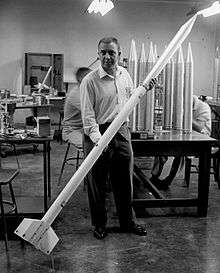
As Time magazine later reported, "Van Allen’s ‘Rockoons’ could not be fired in Iowa for fear that the spent rockets would strike an Iowan or his house." So Van Allen convinced the U.S. Coast Guard to let him fire his Rockoons from the icebreaker Eastwind that was bound for Greenland. "The first balloon rose properly to 70,000 ft., but the rocket hanging under it did not fire. The second Rockoon behaved in the same maddening way. On the theory that extreme cold at high altitude might have stopped the clockwork supposed to ignite the rockets, Van Allen heated cans of orange juice, snuggled them into the third Rockoon’s gondola, and wrapped the whole business in insulation. The rocket fired."
In 1953, the Rockoons and their science payloads fired off Newfoundland detected the first hint of radiation belts surrounding Earth. The low-cost Rockoon technique was later used by the Office of Naval Research and The University of Iowa research groups in 1953–55 and 1957, from ships at sea between Boston and Thule, Greenland.[13][14]
In 1954, in a private discussion about the Redstone project with Ernst Stuhlinger, Wernher von Braun expressed his belief that they should have a "real, honest-to-goodness scientist" involved in their little unofficial satellite project. "I’m sure you know a scientist somewhere who would fill the bill, possibly in the Nobel Prize class, willing to work with us and to put some instruments on our satellite." Stuhlinger, himself a cosmic ray researcher during his college years, and having worked with Van Allen at White Sands with V-2 rockets, was ready with his reply: "Yes, of course, I will talk to Dr. Van Allen."
Stuhlinger followed up with a visit to Van Allen at his home in Princeton, New Jersey, where Van Allen was on sabbatical leave from Iowa to work on stellarator design. Van Allen later recounted, "Stuhlinger’s 1954 message was simple and eloquent. By virtue of ballistic missile developments at Army Ballistic Missile Agency (ABMA), it was realistic to expect that within a year or two a small scientific satellite could be propelled into a durable orbit around the earth (Project Orbiter).... I expressed a keen interest in performing a worldwide survey of the cosmic-ray intensity above the atmosphere."[15]
International Geophysical Year 1957-58
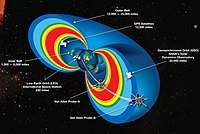
In 1950 an event occurred that began small but was to affect the future of Van Allen and all his countrymen. In March, British Physicist Sydney Chapman dropped in on Van Allen [and] remarked that he would like to meet other scientists in the Washington area. Van Allen got on the phone, soon gathered eight or ten top scientists (Lloyd Berkner, S. Fred Singer, and Harry Vestine) in the living room of his small brick house. ‘It was what you might call a pedigreed bull session,’ he says.... The talk turned to geophysics and the two ‘International Polar Years’ that had enlisted the world’s leading nations to study the Arctic and Antarctic regions in 1882 and 1932. Someone suggested that with the development of new tools such as rockets, radar and computers, the time was ripe for a worldwide geophysical year. The other men were enthusiastic, and their enthusiasm spread around the world from Washington DC. From this meeting Lloyd Berkner and other participants proposed to the International Council of Scientific Unions that an IGY be planned for 1957–58 (during the maximum solar activity).... The International Geophysical Year (1957–58) stimulated the U.S. Government to promise earth satellites as geophysical tools. The Soviet government countered by rushing its Sputniks into orbit. The race into space or Space Race may be said to have started in Van Allen’s living room that evening in 1950.
— Time, 1959
In 1955, the U.S. announced Project Vanguard as part of the US contribution to the International Geophysical Year. Vanguard planned to launch an artificial satellite into an orbit around the Earth. It was to be run by the US Navy and developed from sounding rockets, which had the advantage of being primarily used for non-military scientific experiments.[16]
A symposium on "The Scientific Uses of Earth Satellites" was held on January 26 and 27, 1956 at the University of Michigan under sponsorship of the Upper Atmosphere Rocket Research Panel, chaired by Dr. Van Allen. 33 scientific proposals were presented for inclusion in the IGY satellites. Van Allen's presentation highlighted the use of satellites for continuing cosmic-ray investigations. At this same time his Iowa Group began preparations for scientific research instruments to be carried by 'Rockoons' and Vanguard for the International Geophysical Year. Through "preparedness and good fortune," as he later wrote, those scientific instruments were available for incorporation in the 1958 Explorer and Pioneer IGY launches.
- July 1, 1957: The International Geophysical Year begins. IGY is carried out by the International Council of Scientific Unions, over an 18-month period selected to match the period of maximum solar activity (e.g. sun spots). Lloyd Berkner, one of the scientists at the April 5, 1950 Silver Spring, Maryland meeting in Van Allen's home, serves as president of the ICSU from 1957 to 1959.
- September 26, 1957: Thirty-six Rockoons (balloon-launched rockets) were launched from Navy icebreaker U.S.S. Glacier in Atlantic, Pacific, and Antarctic areas ranging from 75° N. to 72° S. latitude, as part of the U.S. International Geophysical Year scientific program headed by Van Allen and Lawrence J. Cahill of The University of Iowa. These were the first known upper atmosphere rocket soundings in the Antarctic area. Launched from IGY Rockoon Launch Site 2, Atlantic Ocean; Latitude: 0.83° N, Longitude: 0.99° W.
- October 4, 1957: The Soviet Union (USSR) successfully launches Sputnik 1, the world's first artificial satellite, as part of their participation in the IGY.
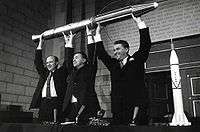
- January 31, 1958: The first American satellite, Explorer 1, was launched into Earth's orbit on a Juno I four-stage booster rocket from Cape Canaveral, Florida. Aboard Explorer 1 were a micrometeorite detector and a cosmic ray experiment designed by Van Allen and his graduate students, with the satellite deployment of the sensor package supervised by Ernst Stuhlinger, who also had an expert cosmic ray background.[17] Data from Explorer 1 and Explorer 3 (launched March 26, 1958) were used by the Iowa group to make "the first space-age scientific discovery": "the existence of a doughnut-shaped region of charged particle radiation trapped by the Earth’s magnetic field".
- July 29, 1958: United States Congress passed the National Aeronautics and Space Act (commonly called the "Space Act"), which created the National Aeronautics and Space Administration (NASA) as of October 1, 1958 from the National Advisory Committee for Aeronautics (NACA) and other government agencies.
- December 6, 1958: Pioneer 3, the third intended U.S. International Geophysical Year probe under the direction of NASA with the Army acting as executive agent, was launched from the Atlantic Missile Range by a Juno II rocket. The primary objective of the flight, to place the 12.95 pound (5.87 kg) scientific payload in the vicinity of the moon, failed. Pioneer III did reach an altitude of 63,000 miles (101 000 km), providing Van Allen additional data that led to discovery of a second radiation belt. Trapped radiation starts at an altitude of several hundred miles from Earth and extends for several thousand miles into space. The Van Allen radiation belts are named after Van Allen, their discoverer.
Later career summary
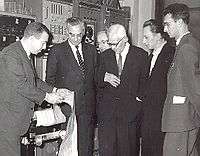
Van Allen headed the University of Iowa Department of Physics and Astronomy until his retirement from teaching in 1985. During the 1950s, he and his graduate students used the UI football practice field to launch rockets and "Rockoons"—rockets carried aloft by balloons—to conduct cosmic ray experiments above the atmosphere. A highlight of that work was the 1953 discovery of electrons believed to be the driving force behind the aurora. In 1956, he proposed the use of U.S. satellites for cosmic-ray investigations and through "preparedness and good fortune," he later wrote, the experiment was selected as the principal payload for the first flight of a four-stage Juno I rocket in October 1957.
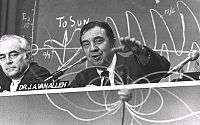
Van Allen played a key role in planning the 1957–58 International Geophysical Year (IGY) and carried out shipboard expeditions to Greenland and southward to the Ross Sea off the coast of Antarctica in 1957. IGY culminated in the Jan. 31, 1958 launch of Explorer 1 and its scientific payload. Van Allen's instruments included a Geiger–Müller tube, which provided data and information that regions of intense radiation surround the Earth. The discovery marked the birth of the research field of magnetospheric physics, an enterprise that grew to involve more than 1,000 investigators in more than 20 countries.
In 1974, People Magazine listed Van Allen as one of the top 10 teaching college professors in the country. His former graduate students list among their accomplishments experiments on NASA's Pioneer 10 and 11, Voyager 1 and 2, Galileo and Cassini spacecraft. Van Allen joined the American Geophysical Union (AGU) in 1948 and served as the organization's president from 1982 until 1984. He has received the AGU's highest honors, including the John A. Fleming Award in 1963 for eminence in geophysics and the William Bowie Medal in 1977 for outstanding contributions to fundamental geophysics and for unselfish cooperation in research.
Also, in 1962, Van Allen became the second recipient of the Daniel and Florence Guggenheim International Astronautical Award presented by the International Academy of Astronautics for noteworthy contributions to astronautics, and in March 2006 he received the 2006 Smithsonian National Air and Space Museum Trophy for lifetime achievement. In 1994, Van Allen received the 1994 Gerard P. Kuiper Prize from the Division of Planetary Sciences of the American Astronomical Society "in recognition of his many contributions to the field of planetary science, both through his investigations of planetary magnetospheres and through his advocacy of planetary exploration." Also in 1994, he was presented with a lifetime achievement award by NASA on the occasion of his 80th birthday and the American Geophysical Union's 75th anniversary.
Van Allen's other awards and honors include membership in the National Academy of Sciences since 1959 and the National Medal of Science, the nation's highest honor for scientific achievement, presented in 1987 by President Reagan in ceremonies at the White House. In 1989, he received the Crafoord Prize, awarded by the Royal Swedish Academy of Sciences in Stockholm and presented by the King of Sweden. The Crafoord Prize is the highest award the Academy can bestow for research in a number of scientific fields and, for space exploration, is the equivalent of the Nobel Prize.
Perhaps his proudest achievement as an educator was leaving his mark on 34 doctoral students, 47 master's degree students and, especially, the numerous undergraduates who enjoyed his classes. In a February 2004 interview he said, "I taught 'General Astronomy' for 17 years, and it was my favorite course. I spent one or two hours preparing for each lecture because I had a genuine enthusiasm for the course. Today, I run into people all the time who say, 'You don't remember me, but I took your course in 1985.' Many former students tell me how much they enjoyed the course."
Pioneer of space science and exploration
The May 4, 1959 issue of Time magazine credited James Van Allen as the man most responsible for giving the U.S. "a big lead in scientific achievement." They called Van Allen "a key figure in the cold war’s competition for prestige. .... Today he can tip back his head and look at the sky. Beyond its outermost blue are the world-encompassing belts of fierce radiation that bear his name. No human name has ever been given to a more majestic feature of the planet Earth."
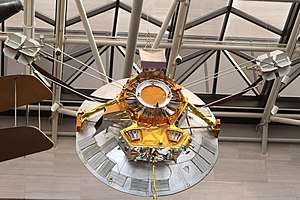
James Van Allen, his colleagues, associates and students at The University of Iowa continued to fly scientific instruments on sounding rockets, Earth satellites (Explorer 52 / Hawkeye 1), and interplanetary spacecraft including the first missions (Pioneer program, Mariner program, Voyager program, Galileo spacecraft) to the planets Venus, Mars, Jupiter, Saturn, Uranus, and Neptune. Their discoveries contributed important segments to the world's knowledge of energetic particles, plasmas and radio waves throughout the solar system.
Van Allen was the principal investigator for scientific investigations on 24 Earth satellites and planetary missions.
Professor emeritus
Van Allen stepped down as the head of the Dept. of Physics & Astronomy in 1985, but continued working at the University of Iowa as the Carver Professor of Physics, Emeritus.
In 1987, President Ronald Reagan presented the National Medal of Science, the U.S.'s highest honor for scientific achievement, to James Van Allen at White House ceremonies. In 1989, he received the Crafoord Prize, awarded by the Royal Swedish Academy of Sciences in Stockholm and presented by the King of Sweden. The Crafoord Prize is the highest award the Academy can bestow for research in a number of scientific fields and, for space exploration, is the equivalent of the Nobel Prize.
On October 9, 2004, The University of Iowa and the UI Alumni Association hosted a celebration to honor Van Allen and his many accomplishments, and in recognition of his 90th birthday. Activities included an invited lecture series, a public lecture followed by a cake and punch reception, and an evening banquet with many of his former colleagues and students in attendance. In August 2005 an Elementary School bearing his name opened in North Liberty, Iowa.
In 2009 Van Allen's boyhood home in Mt. Pleasant, once maintained as a museum, was slated to be demolished.[18] The new owner, Lee Pennebaker, chose not to demolish the home. It was donated to the Henry County Heritage Trust, which plans to move the house next to the old Saunders School which will be the home of the Henry County museum.[19]
Personal life and death
Van Allen's wife of 61 years was Abigail Fithian Halsey II of Cincinnati (1922–2008). They met at the Johns Hopkins University Applied Physics Laboratory (JHU/APL) during World War II. They were married October 13, 1945 in Southampton, Long Island. Their five children are Cynthia, Margot, Sarah, Thomas, and Peter.[20]
On August 9, 2006, James Van Allen died at University Hospitals in Iowa City from heart failure.[21][22]
Professor Van Allen and his wife Abigail are buried in Southampton, New York,[23] where Mrs. Van Allen was born and the couple were married.[24]
Legacy and honors
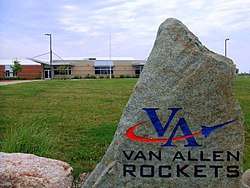
- Time magazine Man of the Year in 1960
- Elliott Cresson Medal in 1961
- Distinguished Fellow, Iowa Academy of Science in 1975
- Gold Medal of the Royal Astronomical Society in 1978
- National Medal of Science in 1987
- Golden Plate Award of the American Academy of Achievement in 1988[25]
- Crafoord Prize in 1989
- Vannevar Bush Award in 1991
- NASA's Lifetime Achievement Award in 1994
- National Air and Space Museum Trophy in 2006
- Van Allen Probes (NASA mission, renamed from the Radiation Belt Storm Probes) in 2012
Van Allen Probes mission
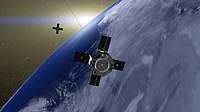
On Nov. 9, 2012 NASA renamed the Radiation Belt Storm Probes (RBSP), a mission to study Earth's Van Allen radiation belts, as the Van Allen Probes mission in honor of the late James A. Van Allen, U.S. space pioneer and longtime distinguished professor of physics in the University of Iowa College of Liberal Arts and Sciences.[26] The Applied Physics Laboratory, where Dr. Van Allen worked for a decade, is responsible for the overall implementation and instrument management for RBSP. The primary mission is scheduled to last 2 years, with expendables expected to last for 4 years.
NASA BARREL mission
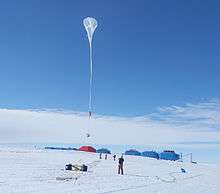
Eighty years after the Second Byrd Expedition, the Balloon Array for RBSP Relativistic Electron Losses (BARREL), a NASA mission began to study Earth's Van Allen radiation belts at the Antarctic (South Pole) managed by Dartmouth College. BARREL launched 20 balloons from Antarctica during each of two balloon campaigns in January–February 2013 and December 2013 – February 2014. This scientific data will complement the Van Allen Probes data over the two-year mission.
See also
- George H. Ludwig
- Stamatios Krimigis (Tom Krimigis)
- Explorer program
- Sputnik program
- Sputnik crisis
- Pioneer 10, Pioneer 11, Pioneer H
Notes
- "Sputnik Biographies—James A. Van Allen (1914– )". history.nasa.gov. Retrieved 3 July 2018.
- "Explorer 1 Scientific instrument". NASA. Retrieved 14 July 2013.
- "Explorer 3 Scientific instrument". NASA. Retrieved 14 July 2013.
- "Pioneer 3 Scientific instrument". NASA. Retrieved 14 July 2013.
- "Van Allen Name Meaning & Van Allen Family History at Ancestry.com". www.ancestry.com. Retrieved 3 July 2018.
- Van Allen. James (1990). "What Is A Space Scientist? An Autobiographical Example". Annual Review of Earth and Planetary Sciences, Annual Reviews, Inc. Retrieved 22 August 2002.
- Van Allen, James A. (1997). Energetic Particles in the Earth's External Magnetic Field. History of Geophysics. 7. American Geophysical Union. pp. 235–251. Bibcode:1997HGeo....7..235V. doi:10.1029/HG007p0235. ISBN 978-0-87590-288-3.
- Byrd, Richard E. (1938). Alone. Ace Books, Inc., New York.
- George Ludwig (9 October 2004). "James Alfred Van Allen: From High School to Beginning of the Space Era - A Biographical Sketch" (PDF). Retrieved 3 July 2002.
- "Department of Terrestrial Magnetism". Carnegie Institution. 11 August 2006. Archived from the original on 25 September 2011. Retrieved 3 July 2013.
- "James Van Allen Biography". Encyclopedia of World Biography. www.notablebiographies.com. Retrieved 2013-06-26.
- "Meetings of Rocket and Satellite Research Panel". Beyond the Atmosphere: Early Years of Space Science. NASA. Archived from the original on 2007-08-23. Retrieved 2007-05-23.
- "Light Ship USCGC Eastwind (WAGB-279)". Stratocat. 2005. Retrieved 17 June 2013.
- "Light Ship USS Colonial (LSD-18)". Stratocat. 2005. Retrieved 17 June 2013.
- George H. Ludwig (9 October 2004). "The First Explorer Satellites" (PDF). p. 2. Retrieved 10 July 2013.
- "Project Vanguard". U.S. Naval Research Lab. Retrieved 5 July 2013.
- George H. Ludwig (October 9, 2004). "The First Explorer Satellites" (PDF). Retrieved 2 July 2013.
- "Van Allen house in Mount Pleasant will be razed". Chicagotribune.com. 22 June 2009. Retrieved 2013-05-30.
- "James Van Allen's boyhood home being moved". Cedar Rapids Gazette. 17 July 2009. Retrieved 2013-05-30.
- "James Van Allen Biography - life, children, parents, wife, school, old, born, college, time - Newsmakers Cumulation". www.notablebiographies.com. Retrieved 3 July 2018.
- Galluzzo, Gary (2006-08-09). "U.S. Space Pioneer, UI Professor James A. Van Allen Dies" (Press release). University of Iowa News Services. Archived from the original on 2011-09-19. Retrieved 2013-06-15.
- "Pioneering Astrophysicist James Van Allen Dies". NASA. 2006-08-10. Retrieved 2013-06-15.
- "James Alfred Van Allen". Find A Grave.
- "Abigail Van Allen Obituary". Iowa City Press-Citizen. Retrieved 20 March 2016.
- "Golden Plate Awardees of the American Academy of Achievement". www.achievement.org. American Academy of Achievement.
- Galluzzo, Gary (2012-11-12). "NASA renames space mission to honor University of Iowa's James Van Allen". IowaNow. Retrieved 2013-06-15.
References
- Brief biography
- Brief NASA biography
- Foerstner, Abigail; James van Allen: The first eight billion miles, 2007.
- Krimigis, Stamatios M.; Planetary Magnetospheres: Van Allen Radiation Belts of the Solar System Planets
- Ludwig, George; The First Explorer Satellites
- Ludwig, George; James Van Allen, From High School to the Beginning of the Space Era: A Biographical Sketch
- Organization of the James A. Van Allen Papers, 1938–1990
- McIlwain, Carl; Discovery of the Van Allen Radiation Belts
- NASA, NASA Radiation Belt Storm Probes Mission
- NASA; Silver Anniversary of Pioneer 10
- Nature; Obituary: James A. Van Allen (1914–2006) in Nature, 14 September 2006. doi:10.1038/443158a
- Dvorak, Todd. (9 August 2006) U.S. Space Pioneer James Van Allen Dies at 91. Space.com
- Tabor, Robert; Artist Robert Tabor Depicts the Discovery of Van Allen Radiation Belts
- Thomsen, Michelle; Jupiter's Radiation Belt and Pioneer 10 and 11
- University of Iowa; Van Allen Day - October 9, 2004 University of Iowa Foundation and UI Department of Astronomy & Physics
- University of Iowa; U.S. Space Pioneer, UI Professor James A. Van Allen Dies
- Van Allen, James A. "Space Science, Space Technology and the Space Station"; Scientific American, January 1986, page 22.
- Van Allen, James; What Is A Space Scientist? An Autobiographical Example
- Van Allen, James A. (2004). Origins Of Magnetospheric Physics: An Expanded Edition. University of Iowa Press. ISBN 978-0-87745-921-7.
- Van Allen Elementary School in North Liberty, IA; Van Allen elementary homepage
- Van Allen Elementary School in Mt. Pleasant, IA; Van Allen elementary homepage
- Wade, Mark; Timeline
- Wolverton, Mark; The Depths of Space: The Story of the Pioneer Planetary Probes. 2004

External links
| Wikiquote has quotations related to: James Van Allen |
- Explorer's Legacy, University of Iowa site including the downloadable data sets from the digitized Explorer I data tapes.
- James Van Allen Papers at the University of Iowa Special Collections & University Archives intro to the collection, and finding aid.
- James Van Allen Papers digital collection – Iowa Digital Library